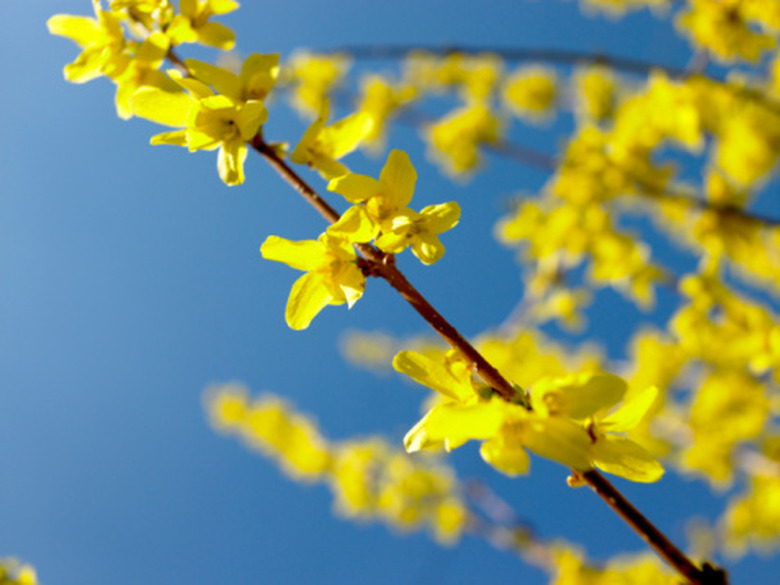When Does Forsythia Bloom?
Forsythia is a spectacular spring-flowering shrub you're more likely to find near old farmhouses than in modern yards, in part because of its size. Forsythia can grow to 10 feet and taller, and equally wide, though smaller cultivars are now available. Also known as border forsythia and golden bell, forsythia explodes with vivid yellow flowers on naked branches when winter is still dreary–a cheering early harbinger of spring–though the month varies from place to place.
Forsythia
A sun-loving deciduous shrub native to Europe as well as China and Korea, forsythia is named after 18th-century Scottish horticulturist William Forsyth. Most varieties have a dramatic arching or fountain-like form, with branches sprouting from the plant base. Forsythia is fast growing and long-lived, excellent as specimen plants and useful in informal hedges and mixed shrub borders.
Forsythia Cultivars
Smaller, more compact cultivars include Sunrise, Karl Sax and variegated Fiesta. Bronxensis is very low growing, and used as a ground cover. Full-sized cultivars that do well in cold climates include Meadowlark, Northern Sun, Northern Gold, New Hampshire Gold and Vermont Sun. Classic 10-foot cultivars include Beatrix Farrand, light-yellow-flowering Lynwood and showy yellow-flowered Spectabilis.
- Forsythia is a spectacular spring-flowering shrub you're more likely to find near old farmhouses than in modern yards, in part because of its size.
- Classic 10-foot cultivars include Beatrix Farrand, light-yellow-flowering Lynwood and showy yellow-flowered Spectabilis.
Forsythia Bloom
In California and other warm-winter areas, forsythia may bloom in January, while in Iowa it typically blooms in mid-April. Clusters of 1-inch-long, bell-shaped flowers range from pale to blazing yellow, depending on variety, and last for two to three weeks unless killed by a cold snap. Forsythia's dark green leaves emerge after bloom. Well-budded forsythia branches can be placed in water and forced into bloom indoors to bring the shrub's spring cheer inside.
Pruning for Strong Bloom
Some gardeners leave forsythia alone, then cut the entire shrub back to the ground every few years to revitalize it. Janet Carson of University of Arkansas Extension prefers to remove 1/3 of older canes every year, cutting them back to the ground to encourage vigorous new growth, but leave most canes in place for continuing enjoyment. Forsythia only blooms on year-old wood, so steady new cane development supports strong blooming. Prune shrubs right after flowering; the growth forsythia produces from that point until early fall will set next year's flower buds. Topping and shaping plants at other times just removes the following year's flowers.
- In California and other warm-winter areas, forsythia may bloom in January, while in Iowa it typically blooms in mid-April.
- Janet Carson of University of Arkansas Extension prefers to remove 1/3 of older canes every year, cutting them back to the ground to encourage vigorous new growth, but leave most canes in place for continuing enjoyment.
Otherwise Encouraging Flowers
Give your forsythias what they need throughout the year to support good growth and strong flowering. They need a minimum of six hours of full sunlight a day in order to bloom, though shrubs may grow in part shade. Forsythia does best in fertile, loose and well-drained soil–good drainage is critical–but will tolerate other conditions.
